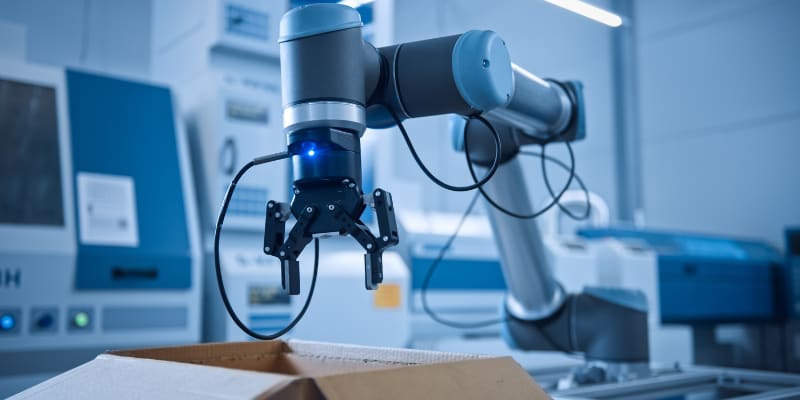CSA Z434 robotics standard update: What Ontario employers need to know

The Canadian Standards Association (CSA) is working towards updating its Z434 Standard for Industrial Robots and Robot Systems. “Essentially, CSA is in the process of nationally adopting the recently published international robot safety standard, ISO 10218:2025 Part 1 and Part 2, as Canada’s new industrial robot safety standard,” says Robert Vomiero, Specialized Consultant in Machine and Robotics Safety with WSPS. “We anticipate that the updated CSA Z434 will include an additional component that will provide end-user guidance on the safe use of industrial robot cells. Topics such as collaborative application technology selection guidance, end-user risk assessment, training, verification and validation, and requirements for maintaining acceptable end-user risk will be covered.”
Part 1 of the standard outlines the requirements robot manufacturers must meet when designing and building robots. Part 2 focuses on the safety requirements when integrating a robot into a robot cell or application. “Robots on their own are not a complete machine until the end-effector is added; they are integrated into a robot cell and then programmed to complete a task or process. So, robot integrators and employers will need to pay attention to the changes in Part 2 of the standard because that is where they will find the requirements for integrating a robot into a robot cell and safely using it in their workplaces,” says Robert.
Introduction of robot classes
One new piece in the update to CSA Z434 will be the introduction of two classes of robots for workplace applications. Class 1 robots are lower risk, while Class 2 robots are higher risk. “A Class 1 robot will be smaller, lighter, with lower force output and speed capabilities,” says Robert. “It poses less risk to humans, so it will have reduced functional safety requirements. However, a Class 2 robot will have greater functional safety requirements due to its increased mass and capacity for greater force output and speed.”
The majority of robots currently implemented in workplaces, such as industrial facilities, warehouses, farms, and greenhouses, are Class 2. However, with the new classification specifications, Robert expects that we may see more Class 1 robots in the future because they could provide a cost-effective option for lighter duty applications with less restrictive cycle times.
Greater guidance for collaborative robot applications
We also expect this update to expand on the requirements for collaborative robot applications, where robots and humans work side-by-side. “Traditionally, humans were kept completely separate from the robot application. But with advances in safety functionality, humans and robots are able to work in a collaborative way within the same safeguarded space. So, the new standard will provide much more guidance and clarity on how to achieve this with effective risk reduction,” explains Robert.
While collaborative application guidance exists in the current standard, the update will go much further into safe implementation practices, including proximity monitoring and force limitations. “For example, if a robot in a distribution centre picks an item and then hands it off to a human, there is risk involved with that contact,” says Robert. “The goal of the updated requirements is to reduce the risk associated with that contact. If the robot application is designed and integrated accordingly, the risk of injury to the human can remain low,” he says, explaining that the speed, force, and pressure outputs of the robot are the key factors that will be limited. He expects to see an even greater emphasis on the design of the end-effector as well, to minimize the risk of the robot seriously harming the human.
Key updates coming in the new standard
If your workplace is planning to implement a new robot application soon, Robert recommends following ISO 10218:2025, in addition to any legislative requirements specific to your jurisdiction. “This will ensure that the integration will align with the requirements of the new CSA Z434 when it is released. Technically, they will be the same,” he says.
Here are a few more details of what you will find in the new standard.
- Additional requirements for cybersecurity to protect networks from being hacked, including requirements for secure access to controls, network segmentation, and fail-safe behaviour during periods of communication loss.
- Clear descriptions for collaborative applications, such as hand-guided control, speed and separation monitoring, power and force limiting, and their associated safety functions.
- Biomechanical force and pressure limits not to exceed for 29 body areas during human-robot contact in collaborative applications.
- Additional clarity on functional safety requirements for various robot safety functions such as emergency stop, normal stop, protective stop, interlocking, reset, start/restart interlock, mode activation, etc.
- Measurement methods for validating pressure and force during contact events for Power and Force Limiting (PFL) collaborative applications.
- The addition of risk assessment protocols specifically focused on robotic applications.
How WSPS can help
Consulting
Connect with a WSPS health and safety consultant to ensure your workplace is compliant with the updated standard.
Free Webinar
Videos
- Safety Tip: What is a collaborative robot?
- Safety Tip: What should businesses know about CSA Z434 Industrial Robot Standard
- Safety Tips: What is the difference between an Autonomous Mobile Robot and an Automated Guided Vehicle?
Training
- Robot Safety Training: Decoding and Applying CSA Z434 (online, instructor-led, 1 day)
- Managing Robot Safety Training (online, instructor-led; 3.5 hours)
The information in this article is accurate as of its publication date.




